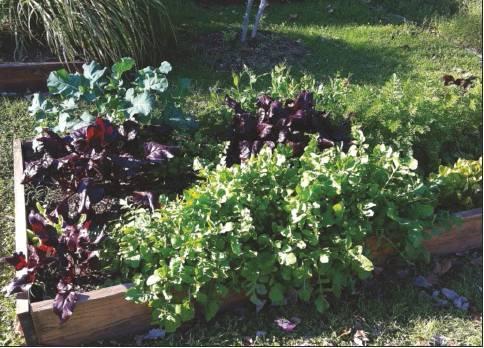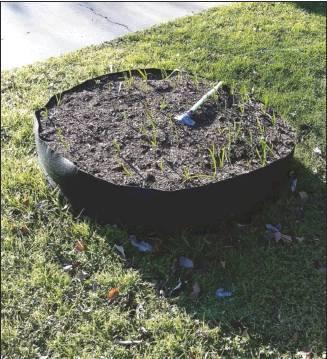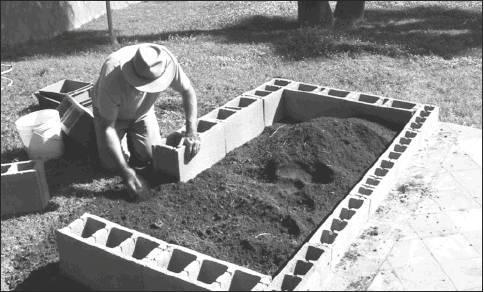Getting into Gardening
Fall garden planning season is here and about this time of year I am usually asked why I grow vegetables in raised beds. What are the advantages and disadvantages? Or as one person asked, “What is really stopping you from growing vegetables just as intensely right in the ground?” Good questions. Let me attempt to answer.
First let’s be clear here, when I refer to conventional gardening methods, I’m not talking about organic vs. non-organic growing. I’m referring to traditional row gardens, in which people till a section of earth, amend the soil, and plant their gardens in rows, with paths to walk on in between.
There is some confusion over the term “raised beds” because many gardeners grow their vegetables in raised mounds of soil in between paths. Others, like me, build containers or frames to hold soil and grow in those. For the sake of simplicity, the focus of this discussion is on the latter.
Also, let me be clear here, I do not grow only in raised beds, I grow things anywhere and everywhere I can, but honestly 9 times out of 10, my veggies do better in my raised beds.
My thinking is this; if you do not have natural soil that has been amended for years, go for the raised beds. You can start with nice soil such as Miracle Grow or Sta-Green brand Garden Soil or better yet use your own composted soil. Also, there is no need to build your beds to an extreme depth either, I’ve grown all sorts of veggies in just six inches of soil and they do extremely well! The only time you’ll need to take pause is if you’d like to plant some especially long carrots or if you’re growing potatoes. In fact, I recommend containers like trashcans for growing potatoes!
Some of the benefits of raised bed gardening are:
• Less Weeds
• Better water retention in areas that have super-sandy soil
• Better drainage in areas with clay soils
• More growing space
• No soil compaction from human feet
• Warmer soil earlier in the season
• Warmer soil for a longer season (often year round)
• Soil that has a neutral pH unless you add something to change it (because you’re filling it)
• Less soil erosion (especially, if the bed is framed)
Back yard gardeners are often instructed to start preparations by digging two feet down into the soil to break up soil compaction, improve drainage, and provide aeration. Try that in our rocky soil!
Besides that, have you ever tried to dig a two-footdeep hole, let alone one 30 inches wide by 12 feet long? Call me lazy, but that’s way too much work for me. The Shovel and I have never really been on the best of terms anyway!
Building raised beds requires some initial investment (primarily in wood, screws, and the soil to fill the beds) and in the time it takes to build. But once you’ve done that, you’re finished with the hard part. Raised beds like the ones I build last for years. I can just plunk them down right on top of grass or whatever happens to be on the ground, no digging needs be involved. I use weed-blocking materials such as cardboard, newspaper or even old phone books underneath, then top with my soil
mix. This way weeds are rarely an issue. Those that do make their way in (airborne, or perhaps some volunteer tomatoes from last year’s crop) are easy to spot and pull out while they’re still tiny. By contrast, weeds are a never-ending battle in conventional row gardens, especially aggressively spreading weeds such as Johnson grass.
I fill my frames and containers with a very light, organic soil mix that retains water well, never gets soggy, and is very easy to work with.
Yes, bringing in soil costs more than just planting “right in the ground,” but the results are superior, and the process is considerably less frustrating and takes much less time and effort. With regular additions of small amounts of compost at planting or harvest time, soil like this lasts for years, requires no additional fertilizer or other amendments, and is suitable for growing nearly any vegetable or herb. Moreover, because I never walk on it, the soil never gets compacted and never requires tilling.
Finally, raised-bed gardens are considerably more efficient than row gardens, taking up as little as 20 percent of the space to grow the same amount of produce. Because of that and well-thought-out succession planting and design, I’m able to install incredibly efficient and productive gardens for myself, my family and my clients, even for those who have very small yards or just sunny patios to work with. (Yes! You can put a raised bed garden right on a concrete patio or even a deck or balcony landing!!)
Just some of the benefits of the Raised Bed Garden:
• Increased Productivity - According to Ohio State University, among others, raised beds are more productive per square foot because plants can be spaced more closely together. This is because you don’t need to leave spaces to walk through, because you don’t need to ever step on the garden bed, ever. Having a higher density planting also has the advantage that the plants growing there will shade out bare soil, making it harder for weeds to grow there. There most important benefit of raised garden beds is productivity. Raised garden beds are at least twice as productive as a conventional garden and often even more so.
• Better Soil Conditions - Since there is no soil compaction, there is no need to plow, till, fork or dig the soil to loosen it up – these! You can use raised garden beds to overcome issues of poor drainage, poor soil, or even no soil, such as gardening right on top of concrete or asphalt. Because you create the garden bed and fill it with the type of soil you require, and build it by adding organic matter, you can garden anywhere. By not having to step on the soil, you avoid soil compaction. When soil is compacted, water and air do not move as easily through the soil to the roots of plants. Even the plant roots themselves have trouble growing through compacted soil, limiting the plant’s access to water and nutrients. It has been suggested that soil compaction alone can lead to a 50% loss in productivity.
• More Efficient Irrigation - Additionally, raised beds can support very thick layers of mulch above the soil, which will not slide off, or be blown or washed away. This not only aids in water conservation but allows you to enrich and build the soil through the constant addition of organic matter.
If you’ve never planted vegetables in raised beds before, I promise that once you do, you’ll be spoiled for the rest of your gardening life. But it just might be a risk you’ll be willing to take.
Let me ask you this: “How much work do you want to have to put into a garden to get great results?”
For me the answer is a simple one: “As little as possible!” That’s why I grow my onions and garlic in my clay soil the conventional way – they love this soil. But everything else is grown in raised beds.






